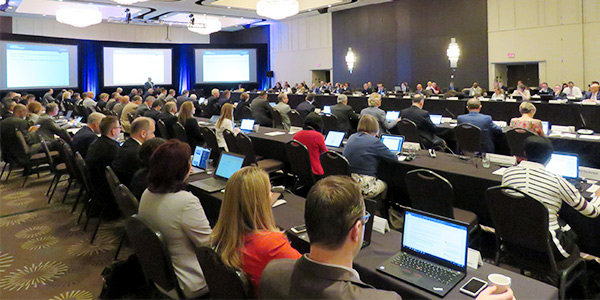By Rich Heidorn Jr.
QUEBEC CITY, Quebec — NERC will delay the first release of its Align software project from September to 2020 to allow inclusion of security features originally planned for a later release.
NERC Chief Technology Officer Stan Hoptroff announced the change at a meeting of the Technology and Security Committee on Wednesday, saying the regional entities wanted to see security capabilities planned for Release 3 included in the initial rollout.
“The board was in full support of this delay,” committee Chair Suzanne Keenan said. “We’ve got to get it right, and we will.”

NERC committees are meeting for two days in Quebec City. | © ERO Insider
Hoptroff said the additional security features concern “evidence lockers” to hold data from enforcement cases. Release 1 is now expected in the first or second quarter of 2020.
The announcement came after it was disclosed at SERC’s quarterly open forum July 29 that only two REs, Midwest Reliability Organization and Texas Reliability Entity, would be involved in the initial rollout of Align Release 1. (See Align Rollout to be Staggered.)
Hoptroff said MRO and TRE will still be the first two REs brought online.

NERC Board Member Suzanne Keenan | © ERO Insider
“I still like the idea of starting with Texas and the MRO because [TRE Chief Operating Officer] Jim Albright is our [Align] Steering Committee chairman and [MRO CEO] Sara Patrick is our executive sponsor,” he said in an interview after the meeting. “So, it’s only appropriate they go first. It would be inappropriate for them to ask another region to go [first]. They are also using the system [currently]. So, if we had to roll back, it would be easier than having to go back to two different separate systems.”

NERC CTO Stan Hoptroff | © ERO Insider
Hoptroff also said NERC management has resolved its concerns over the sale of the organization’s vendor, BWISE Information Security, to SAI Global, an Australia-based company whose investors include a private equity fund managed by a Hong Kong company. (See NERC Investigating Chinese Tie to Software Vendor.)
“I am confident” the ownership poses no security concerns, he said.
Hoptroff said the most recent survey on Align, which ended June 28, documented increasing awareness, with 63% indicating familiarity with the project, up from 47% during the baseline assessment in March. About 67% agreed or strongly agreed with the business need and value of Align, an increase from 58% in March.
Hoptroff emphasized training on Align will not be a “one-time” event. With 5,000 users expected to use Align, a 10% annual turnover would mean the need to train 500 new people per year, he said.
CORES Rollout
Ryan Stewart, senior manager registration and certification, gave the committee an update on the Centralized Organization Registration ERO System (CORES) project, which will become the single registration tool for the ERO Enterprise.
Data entered into CORES will be integrated with Align. “Everything starts with registration data,” Stewart said.
He likened the system to airport security, with the user name and login functioning like a passport and boarding pass. Once inside, “going from one application to another” will not require additional security, he explained. “You don’t need to log out. You don’t need to log back in.”
It will provide a “one-stop shop” for contact information and include filtering tools for generating customized reports, Stewart said.
CORES will be introduced over the next several months in a “managed rollout” that will include one- to five-minute “how to” videos. Twenty entities in the ReliabilityFirst region have begun validating their data in the system.
“This is a truly transformational way for us to manage our registration process and database,” NERC CEO Jim Robb said.
SAFNR
Hoptroff also briefed the committee on version three of the Situational Awareness for NERC, FERC and Regions (SAFNR) system, which is scheduled to launch in the third quarter.
SAFNR was initiated by NERC in 2009 in response to recommendations from the U.S.-Canada Power System Outage Task Force, which concluded that the 2003 blackout was caused by a lack of situational awareness.
The new version will provide more detailed data than the existing program, which is limited to systems 230 kV and above and generation units of 500 MW and higher. It will also include visual indicators to alert users of state changes and visualization features on weather and geography.
Displays will show hourly balancing authority loads, forecasted loads and net interchanges, and detailed outage data by geography or company.
“It’s not a single-use application,” Hoptroff said. “It’s a platform that can then be expanded.”



